


Astron. Astrophys. 57, 97-104 (1977)
1 Kapteyn Astronomical Institute, University of Groningen, The Netherlands 2 Observatoire de Paris, F-92190 Meudon, France
Summary. 21-cm H I line observations are reported for the Seyfert galaxy NGC 4151. No H I is seen in absorption in front of the nucleus except a possible weak narrow feature which may be H I in the disk. The H I emission distribution has been mapped with 60" resolution and the velocity field determined. The velocities from 1' to 5' from the centre are consistent with pure rotation and a dynamical major axis in position angle 19°. This supports the conclusion that the central dominant structure is a thick bar. The H I distribution is coincident with the faint outer optical arms.
Key words: Galaxies - Seyfert galaxies HI distribution - velocity field
NGC 4151, classified as a Sab galaxy (De Vaucouleurs and De Vaucouleurs, 1964), is the brightest and most extensively studied of the Seyfert galaxies. [For a list of references see Brosche et al. (1974)]. Optically the galaxy consists of a very small bright nucleus, with dimensions < 0.08" in the continuum (Schwarzschild, 1973) and about 5" in the emission lines (Ulrich, 1973), surrounded by an elliptical structure with dimensions 3.3' × 2.1' and a major axis position angle ~ 130°. Deep photographs reveal a faint outer spiral arm structure, extending over an approximately circular area 8' in diameter [see photograph and sketch by Davies (1973), Simkin (1975) and Arp (1977)].
Interest in NGC 4151 has been mainly concentrated
on its nucleus, which is a relatively strong radio source
with a size  2"
(De Bruyn and Willis,
1974),
and an intense infrared source
(Low and Kleinmann,
1968).
The nucleus is probably also an X-ray emitter
(Gursky et al., 1971;
Giacconi, 1973).
Permitted emission lines
show very broad wings and probably originate in very dense regions
(Souffrin, 1969).
2"
(De Bruyn and Willis,
1974),
and an intense infrared source
(Low and Kleinmann,
1968).
The nucleus is probably also an X-ray emitter
(Gursky et al., 1971;
Giacconi, 1973).
Permitted emission lines
show very broad wings and probably originate in very dense regions
(Souffrin, 1969).
The outer parts of the galaxy and even the central elliptical structure are not as well studied as the nucleus. Allen et al. (1971) detected 21-cm H I emission from the galaxy and Davies (1973) showed that the H I emission extends over 9', a size comparable to the faint outer spiral structure. Davies also found that the dynamical major axis was in position angle 26°, quite different from the position angle of the central elliptical structure. Simkin (1975) also found a major axis position angle of ~ 26° and an inclination of 21°, from photometry of the outer arms.
Anderson (1974) pointed out that if this value for the dynamical major axis also applies to the central region, then the evidence for large non-circular motions (Anderson and Kraft, 1969; Ulrich, 1973) is much less convincing. New spectroscopic observations of the central region by Fricke and Reinhardt (1974) confirm that the dynamical major axis is near the value found in the outer region of the galaxy, although some non-circular motions are still required to explain the observations.
The present study was undertaken with two different purposes: 1) to search for 21-cm line absorption in the radio nucleus of NGC 4151 and 2) to extend the work of Davies (1973) by observing the structure and velocity field of the 21-cm line emission over the whole galaxy with higher spatial resolution. We describe the absorption measurements and their interpretation in Part II of this paper, the 21-cm line observations in Part III and the dynamics derived from these observations in Part IV. Some other galaxies in the field around NGC 4151 are described in Part V.
II. 21-cm Absorption in the Nucleus of NGC 4151
Several observations suggest the presence of a large amount of absorbing material close to the nucleus of this galaxy. The X-ray spectrum (Giacconi, 1973) has a low energy out-off which, if explained by absorption of X-ray radiation from the nucleus by interposed atoms, leads to a column density of ~ 5 × 1023 at cm-2 Recently, Ives et al. (Astrophys. J. Letters 207, L 159, 1976) have remeasured the low-energy absorption in the X-ray spectrum of NGC 4151 using the Ariel-5 satellite; they derive a total column density in front of the nucleus of only 5 × 1022 H atoms cm-2
Such a high column density could only be found in the nuclear region. Anderson and Kraft (1969, 1971) and Anderson (1974) find variable absorption lines of hydrogen and helium in the spectrum of the nucleus, which also show that high density gas must be present. Absorption in the 21-cm line in the high velocity component of the Seyfert galaxy NGC 1275 has been reported by De Young et al. (1973) and shown to occur in the nuclear component by Ekers et al. (1976), but the interpretation of these observations is still enigmatic. Dent (1971) placed upper limits for 21-cm absorption in the Seyfert galaxies NGC 1275 (low velocity component) and NGC 1068.
The search for absorption was made in the heliocentric velocity range 0-2000 km s-1, where gas motions can be expected.
In the velocity range of the 21-cm emission (about 100 km s-1 at each side of the systemic velocity) good spatial resolution is required to separate any possible absorption in the nucleus from the emission from the rest of the galaxy. In this velocity range we used the Westerbork Synthesis Radio Telescope (WSRT) and its 80-channel spectrometer (Allen et al., 1974). Only the longer interferometer spacings were used, giving a 24" × 31" beam and filtering out the low spatial frequency components. Two settings of the local oscillator were used, giving 16 channels spaced at 20 km s-1. between 845 and 1165 km s-1. 15 h of integration time were obtained without particular regard to good hour-angle coverage.
No emission except from some continuum field sources and the nuclear source was visible, indicating little fine structure in the neutral hydrogen. The overall gain stability was not sufficient to derive an accurate flux density of the nuclear source in each channel map, however the channel-to-channel stability was excellent so we subtracted the average of all 16 channels from each map. In Figure 1 we present this relative flux density for each channel, together with an estimate of the rms noise. The flux density of NGC 4151 at 1420 MHz is 337 mJy 1. From Figure 1 we can see marginal evidence (36) for absorption in the range 965-1065 km s-1. These observations are insensitive to broader band absorption.
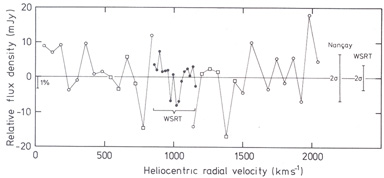 |
Figure 1. 21-cm absorption spectrum in front of the radio nucleus of NGC 4151. In the range 850-1150 km s-1 the spectrum is obtained with the WSRT and has a resolution of 20 km s-1, the rest of the spectrum is obtained at Nancay and has a resolution of 60 km s-1. Errors bars (± 1 rms) are indicated on the right. |
Outside the range of emission velocities a single dish can be used to search for absorption. The Nancay radiotelescope was used for a total of 2 h doing on-off observations covering the velocity range 30-810 and 1170-2170 km s-1 with 60 km s-1 resolution. Because of differences in ground radiation in the "on" and "off" measurements accurate flux densities could not be determined in each channel so we again subtracted the average over all channels. In Figure 1 we present the relative flux density for each channel. The results obtained with the same radio telescope by Allen et al. (1971) outside the emission velocities are combined with this data. No absorption significantly greater than the noise is visible. The dips at 780 km s-1 and at 1380 km s-1 are at the 2.56 level. In order to check for broader band absorption drift curves in the 60 km s-1. channels were obtained at Nancay and compared to drift curves in a 15 MHz channel. No absorption is visible but the accuracy is rather low (about 5 %).
1 1 mJy = 10-29 W m-2 Hz-1. Back.
These observations can be used to set a limit on

 dV
where
dV
where  is the optical depth
and V the velocity of the neutral
hydrogen. These limits can be interpreted as a limit on
the column density NHo using
NHo = 1.8 × 1018
T
is the optical depth
and V the velocity of the neutral
hydrogen. These limits can be interpreted as a limit on
the column density NHo using
NHo = 1.8 × 1018
T
 dV
cm-2 where T is the temperature in Kelvins. We
divide our results into 3 cases:
dV
cm-2 where T is the temperature in Kelvins. We
divide our results into 3 cases:
(i)
no very broad band (1000 km s-1) 21-cm ab-sorption larger
than 5%. This corresponds to

 dV < 40 km
s-1 and hence
NHo < 7.2 × 1019
T cm-2
dV < 40 km
s-1 and hence
NHo < 7.2 × 1019
T cm-2
(ii)
no intermediate band (60 km s-1 21-cm absorption larger than
6% (3 ), corresponding to
NHo < 6.5 × 1018
T cm-2,
), corresponding to
NHo < 6.5 × 1018
T cm-2,
(iii)
no narrow band (20 km s-1 21-cm absorption larger than 3 %
(3 ), corresponding to
NHo < 1.1 × 1018
T cm-2. If the absorption present around
1020 km s-1 with a width of 70 km s-1 is real it
corresponds to
NHo = 2.4 × 1018
T cm-2.
), corresponding to
NHo < 1.1 × 1018
T cm-2. If the absorption present around
1020 km s-1 with a width of 70 km s-1 is real it
corresponds to
NHo = 2.4 × 1018
T cm-2.
Since the temperature is not directly known we
have to rely on models in order to determine limits on
the column densities of the neutral hydrogen. Further,
since the models determine T for the ionized gas, we
must in addition assume which fraction of the gas is
neutral, and also take the non-homogeneous distribution of the gas into
account. The broad-band absorption
can only arise in the very central regions, at the border
or inside the small radio nucleus (r
 100 pc). In this
region the temperature may have a value of 1.2 × 104 K
(Anderson, 1974),
so our upper limit leads to
NHo < 7 -14 × 1023
cm-2 Since this is comparable to the column
density of neutral plus partly ionized matter as derived
from the X-ray low-energy cut-off, it is clear that we
obtain no new information from our broad-band data (i).
100 pc). In this
region the temperature may have a value of 1.2 × 104 K
(Anderson, 1974),
so our upper limit leads to
NHo < 7 -14 × 1023
cm-2 Since this is comparable to the column
density of neutral plus partly ionized matter as derived
from the X-ray low-energy cut-off, it is clear that we
obtain no new information from our broad-band data (i).
However, we can place some upper limits to the amount of ejected gas which has cooled to ~ 100 K and recombined. From (ii) gas with velocities (with respect to the nucleus) between 150 km s-1 and 1000 km s-1 and a velocity dispersion less than 60 km s-1 and a temperature of 100 K has a column density NHo < 6.5 × 1020 cm-2. Similarly if V < 150 km s-1 and the velocity dispersion < 20 km s-1, we have from (iii) NHo < 1.1 × 1020 cm-2. Similar results have been. obtained by Dent (1971) for NGC 1068 and the low-velocity component of NGC 1275. These upper limits may be relaxed if excitation of neutral hydrogen by Lyman a radiation from the nucleus raises T above 100 K (Bahcall and Ekers, 1969).
The lower resolution observations with the WSRT
described later indicate that the brightness temperature
in the 21-cm emission line is  2 K close to the nucleus.
If the absorption seen in the WSRT observations close
to the systemic velocity is real, this yields a temperature
< 250 K for the neutral hydrogen, assuming that it is
uniformly distributed. This low temperature and the
similarity of the column density
(
2 K close to the nucleus.
If the absorption seen in the WSRT observations close
to the systemic velocity is real, this yields a temperature
< 250 K for the neutral hydrogen, assuming that it is
uniformly distributed. This low temperature and the
similarity of the column density
( 6 × 1020
cm-2) with
that perpendicular to the plane in a spiral galaxy
suggest that we may be dealing with ordinary interstellar gas.
6 × 1020
cm-2) with
that perpendicular to the plane in a spiral galaxy
suggest that we may be dealing with ordinary interstellar gas.
In conclusion, our 21-cm absorption observations of NGC 4151 do not show evidence of any exceptional activity in H I comparable to that observed in H II in Seyfert galaxies.
III. 21-cm line Emission from the Disk of NGC
4151
The WSRT (with its 80-channel spectrometer) has also been used to study the 21-cm line emission in NGC 4151 by obtaining measurements with the shorter interferometer spacings. These were done at three different settings of the local oscillator, giving 24-channel maps ranging in velocity from 735 to 1295 km s-1 in intervals 40 km s-1, except between 875 and 1175 km s-1 where the interval is 20 km s-1. Full hour angle coverage was obtained for spacings from 36 m to 684 m in steps of 72 m giving a synthesized beamwidth of 50" × 65" and the first grating response at 10' × 13'. The rms noise level is about 0.7 K in each channel. The channel-to-channel gain stability was checked by measuring the amplitude of the central point source. The values of this amplitude for each channel agreed within the noise (2 %). Heliocentric radial velocity (km s-1).
The central point source was first subtracted from all channel maps. Four channels at the low velocity side and four channels at the high velocity side were found to contain no line emission so these channels were averaged to form a continuum map and this map was subtracted from the remaining "line" channel maps. No extended continuum emission > 0.3 K is seen from the disk of NGC 4151. Since we have uniform spatial coverage and adequate sampling the channel maps are already of high quality, however, they have still been corrected using the CLEAN procedure (Högbom, 1974) in order to avoid sidelobe effects and to obtain an estimate of the integral profile.
In Figure 2 we show the 9 channel maps with detectable signal. For the calculation of line profile integrals and intensity weighted mean radial velocities we have employed the reduction method described by Bosma (1977). Extensive checks of the results of this method have been made by inspecting position-velocity curves along a wide variety of lines through the galaxy. In all cases satisfactory agreement (< 5 km s-1 difference) has been found.
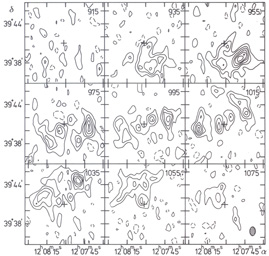 |
Figure 2. Maps of the 21-cm line emission of NGC 4151 in nine velocity channels. Contour units are 1.2 K, dashed contours are negative. The heliocentric velocity (in km s-1) of each channel map is indicate in the top right corner; the position of the nucleus of NGC 4151 is marked with a cross. The beamsize (half power beamwidth 50.8" × 79.7") is shown in the 1075-map. |
The integrated profiles obtained from the cleaned channel maps compare well with the integrated profiles measured with the Dwingeloo 25-m dish (Van der Hulst et al., 1975) and by Davies (1973), indicating that the low spatial frequency components are not lost in our observations. The map of the distribution of integrated H I column density is shown in Figure 3, superposed on a deep photograph, taken at Hale Observatories and kindly made available to us by Dr. H. C. Arp. Note the relative lack of H I in the centre, which must be at least partly real since the possible absorption discussed in Section II cannot account for more than half of the central dip.
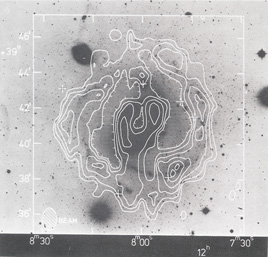 |
Figure 3. Map of the H I column density distribution in NGC 4151. The contour interval is 1.2 × 1020 at cm-2. The first contour has a value of 1.2 × 1020 at cm-2 The optical photograph is from a print of two 200"-plates taken by Dr. H. C. Arp of the Hale Observatories. |
The hydrogen in the main body of the galaxy correlates with the optical features. The faint outer arms are clearly visible in the H I. No radiation above the detection level has been found in the regions between the faint arms and the main body of the galaxy.
A lower resolution H I map was obtained by smoothing the channel maps to a beam of 3' × 3' (HPBW) and processing these in the same manner as described above. The resulting H I map is clearly circular in appearance, making it difficult to establish the inclination of the galaxy on the line of sky.
The velocity field is shown in Figure 4, superimposed on the photograph taken by Arp. The position angle of the kinematical major axis of the galaxy seems to vary as function of radius, and there is also some difference between the SW and the NE side. The mean value is about 20°, confirming the result of Davies (1973) obtained with a lower angular resolution. position-velocity diagrams along various lines crossing the galaxy are shown in Figure 5. In Figure 5a, which is a cut at position angle 20° we can see the form of the rotation curve. From Figure 5b at 110° we can conclude that the position angle of the kinematical major axis of the central elliptical body agrees to within 10° with the axis derived from the outer arms region. From Figure 5c it is clear that the main body of the galaxy is not rotating in such a way that the major axis of the galaxy is at pa = 130°. Therefore we must conclude that the central elliptical structure is a thick bar in agreement with Simkin (1975). The two main outer arms begin at the extremities of this bar, as in many barred spiral galaxies. However, as noticed by Davies (1973), the main peculiarity of NGC 4151 if it is a SBa or SBb galaxy is the existence of spiral structure inside the bar.
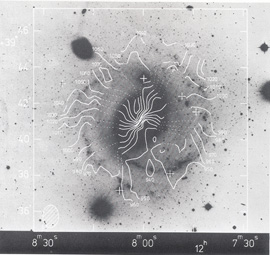 |
Figure 4. Map of the radial velocities in NGC 4151, again superimposed on the print provided by Dr. Arp. The number indicates heliocentric velocities in km s-1. Dashed lines are drawn in areas where no velocity determination was possible. |
Study of the individual profiles shows that the profiles in the main body are generally broader than in the outer arms. This can also be seen in Figure 5. The crosses in panel c are the values for the radial velocities at those points obtained by Simkin (1975) from [O II] lines. Our beamwidth is too large and our present sensitivity level not adequate enough to make definite statements about the suggested double nature of the profiles in Figure 5c.
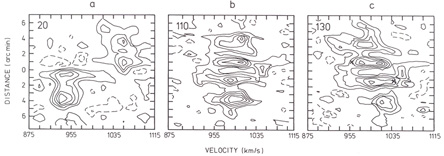 |
Figure 5. Position-velocity plots along lines through the nucleus. These plots were determined from the channel maps by interpolation and sampling every 15". a In position angle 20°, b in position angle 110° and c in position angle 130°. The crosses in c represent the radial velocities found by Simkin (1975) from the [O II]-lines. |
In order to derive some of the parameters describing the
orientation of the galaxy in space we must make some
simple assumptions. First, we assume that the galaxy
is in a plane and that the outer arms lie in a circular disk.
We can then use the method outlined by
Warner et al. (1973)
to derive the circular velocity for a given
dynamical major axis position angle,
 , and inclination,
i. The best fit for
, and inclination,
i. The best fit for
 and i is obtained by
minimizing the deviation from circular rotation for annuli 1' wide. In
our case this procedure is insensitive to the inclination
so we have used i = 21°± 5
(Simkin, 1975)
which is consistent with upper limits derived from the axial ratio
of our smoothed H I distribution. The values of
and i is obtained by
minimizing the deviation from circular rotation for annuli 1' wide. In
our case this procedure is insensitive to the inclination
so we have used i = 21°± 5
(Simkin, 1975)
which is consistent with upper limits derived from the axial ratio
of our smoothed H I distribution. The values of
 obtained for each 1' annules are plotted in
Figure 6.
Since the data for each of the annuli are almost completely independent
the agreement between these values
indicates that the dynamical major axis is quite well
determined and has a similar value between 1' and 5
from the centre. There is some indication of an increase
in
obtained for each 1' annules are plotted in
Figure 6.
Since the data for each of the annuli are almost completely independent
the agreement between these values
indicates that the dynamical major axis is quite well
determined and has a similar value between 1' and 5
from the centre. There is some indication of an increase
in  going towards the centre
but this variation may be
partly due to the difference between the SE and the NW
sections (cf. Fig. 4).
going towards the centre
but this variation may be
partly due to the difference between the SE and the NW
sections (cf. Fig. 4).
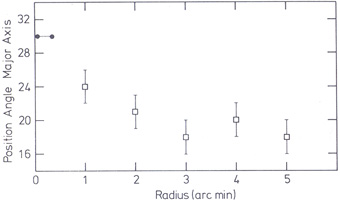 |
Figure 6. Variation of the position angle of the major axis as function of radius. The error bars are estimates from the WSRT data. The black dots are taken from the fit by Fricke and Reinhardt (1974) to their observations at 3 and 20" radius. |
A rotation curve has been calculated for
 = 19°
and i = 21° by again assuming symmetry and averaging
in annuli. These values are shown in Figure 7
together with the value obtained for the rotational velocity by
Fricke and Reinhardt
(1974)
at 3" radius. Unfortunately no data exists to bridge the gap
between this point and the first radio point.
= 19°
and i = 21° by again assuming symmetry and averaging
in annuli. These values are shown in Figure 7
together with the value obtained for the rotational velocity by
Fricke and Reinhardt
(1974)
at 3" radius. Unfortunately no data exists to bridge the gap
between this point and the first radio point.
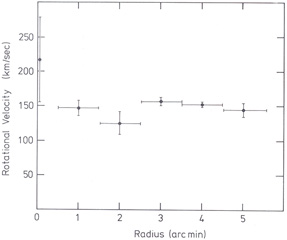 |
Figure 7. Rotation curve of NGC 4151. The error bars for the WSRT points represent the deviation from the mean circular velocity in annuli of 1' wide. The point close to the nucleus is taken from Fricke and Reinhardt (1974). |
Our treatment is not entirely justified since the
central elliptical structure does not posses circular
symmetry in a planar model. If we deproject the central
structure with i = 21° then we have a thick bar with axis
ratio of at most 1.4:1 and this bar should have distorted
the circular symmetry. However, Figures 4 and
5
suggest that the circular motion is still the dominant
mode. The agreement in the value of
 between the
outer spiral structure, the thick bar and the central
region indicates that the interpretation of the optical
velocities mainly as rotational velocities
(Anderson, 1974;
Fricke and Reinhardt,
1974)
is justified.
between the
outer spiral structure, the thick bar and the central
region indicates that the interpretation of the optical
velocities mainly as rotational velocities
(Anderson, 1974;
Fricke and Reinhardt,
1974)
is justified.
Both the light distribution and the very rapid rise
in the rotation curve within 300 pc indicate that NGC 4151 has a high central mass concentration
(~ 2 × 109
M within
300 pc). In the outer parts the
rotation curve remains quite flat, indicating that the
surface density is decreasing only slowly with radius
This is in contrast to the sharp drop in optical luminosity
and may indicate an increase in the M / L ratio especially
in the region of the faint outer spiral arms. Due to
uncertainties in the rotation curve in the inner parts we
cannot properly construct a mass model. However, we
can estimate the mass within the outermost observed
point on the rotation curve assuming the Keplerian
approximation. If we use H0 = 75 km s-1
Mpc-1, the distance to NGC 4151 is 13.8 Mpc and the mass
within 20 kpc (5') is 1.0 × 10112
M
within
300 pc). In the outer parts the
rotation curve remains quite flat, indicating that the
surface density is decreasing only slowly with radius
This is in contrast to the sharp drop in optical luminosity
and may indicate an increase in the M / L ratio especially
in the region of the faint outer spiral arms. Due to
uncertainties in the rotation curve in the inner parts we
cannot properly construct a mass model. However, we
can estimate the mass within the outermost observed
point on the rotation curve assuming the Keplerian
approximation. If we use H0 = 75 km s-1
Mpc-1, the distance to NGC 4151 is 13.8 Mpc and the mass
within 20 kpc (5') is 1.0 × 10112
M . This
can be compared with a H I mass of 3.6 × 109
M
. This
can be compared with a H I mass of 3.6 × 109
M and a
luminosity of 1.1 × 1010
L
and a
luminosity of 1.1 × 1010
L (Roberts, 1976).
(Roberts, 1976).
The morphology of this system is reminiscent of that of some other systems with thick bars; De Vaucouleurs (1975) describes the lenticular barred spiral NGC 1291 in a similar way and Bosma et al. (1976) find a similar picture for the ring galaxy NGC 4736. It is also interesting to note that at least two other Seyfert galaxies, NGC 1068 and NGC 1566, have fat bars and outer rings and also the N galaxy 3C 120 is now known to posses a faint outer disk (Arp, 1975).
V. Other Galaxies in the Field
Several other galaxies are present in the 1 square degree area of sky we have synthesized. Holmberg (1937) lists two groups of galaxies: Ho 345 with members NGC 4151, NGC 4156 and a small galaxy U 07188 listed in the catalogue of Nilsson (1973); and Ho 342 with members NGC 4145 and U 07175. Arp (private communication) has measured redshifts of 6700 km s-1. for NGC 4156 and 5200 km s-1 for U 07158. These are outside the velocity range covered by our observations (735-1295 km s-1. The results obtained for the other galaxies are summarized in Table 1. The WSRT profile for U 07175 is shown in Figure 8, and Dwingeloo profile of NGC 4145 in Figure 9.
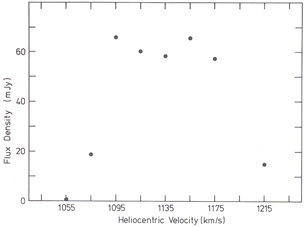 |
Figure 8. Integral H I profile for U 07175 derived from the WSRT channel maps and corrected for the primary beam attenuation. The rms noise is about 10 mJy. |
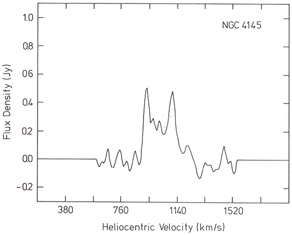 |
Figure 9. Integral H I profile of NGC 4145, measured with the Dwingeloo radio telescope and a 256-channel autocorrelation receiver (Van der Hulst et al., private communication). The rms noise is 80 mJy; the velocity resolution is 16.5 km s-1. |
| Galaxy | H I flux density | V |
 V
a V
a |
MHI | Mtot |
| Jy km s-1 | (km s-1) | (km s-1) |
(M ) ) |
(M ) ) |
|
| 4151 | 79.3 | 1000 | 132 | 3.6 × 109 |
 1 ×
1011 1 ×
1011 |
| 4145 | 75.6 | 1026 | 217 | 3.4 × 109 | ~ 8.6 × 1010b |
| U 07175 | 8.1 | 1139 | 120 | 3.8 × 108 | ~ 4.2 × 109 |
| a Velocity width at half intensity | |||||
| b Values obtained from the single dish profile (Van der Hulst et al., private communication) | |||||
The Seyfert galaxy NGC 4151 has been studied in the 21-cm line of atomic hydrogen with the initial purpose of trying to find peculiarities connected with the nuclear activity characteristic of Seyfert galaxies, such as non-circular motions or asymmetric distributions of gas. No hydrogen has been seen in absorption in front of the nucleus apart from a possible narrow absorption which might simply correspond to hydrogen in the disk of the galaxy. The distribution and velocity field of the hydrogen seen in emission exhibits no strong deviation from symmetry and circular velocities: the non-circular motions detected optically seem to be confined to the vicinity of the nucleus.
The hydrogen map shows a pronounced concentration around 3.5' = 20 kpc, coinciding with the faint optical arms. In the inner parts of the galaxy there is some evidence that the H I is coincident with the blue spiral patches at a radius of ~ 1 : 2 at either side of the center.
The position angle of the dynamical major axis is 19± 4°. It is very different from the position angle of the main elliptical optical body of the galaxy (130°), which must be a thick bar. However, the dominant motions are still circular and its nuclear activity does not seem to have significantly effected its structure.
Acknowledgements. We thank the staff of the Netherlands Foundation for Radio Astronomy for their assistance in obtaining the WSRT data and in the early reduction stages. The final stages of data reduction have been made using the facilities of the University of Groningen Computing Centre. We are grateful to H. C. Arp for providing us an excellent photograph of NGC 4151 prior to publication, and to J. M. van der Hulst and S. M. Simkin for helpful discussions.
The Westerbork Radio Synthesis Telescope is operated by the Netherlands Foundation for Radio Astronomy which is financially supported by the Netherlands Organization for the Advancement of Pure Research (Z.W.O.).